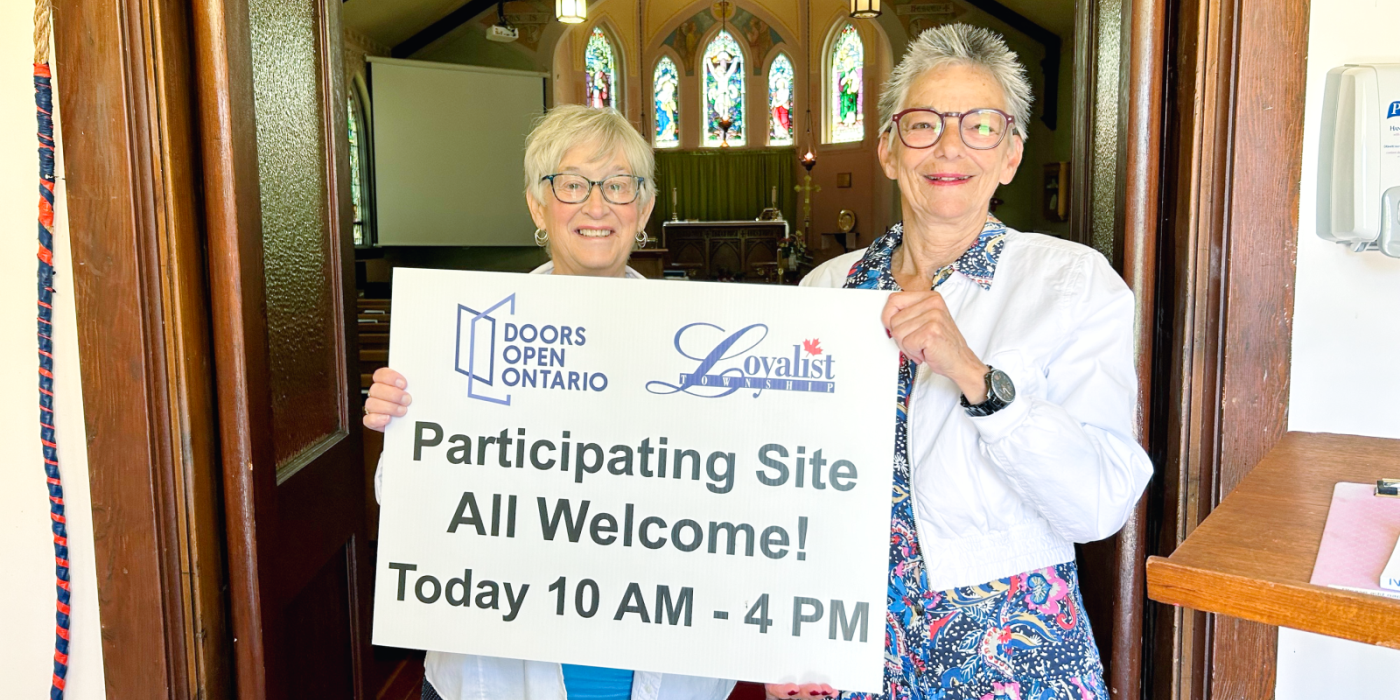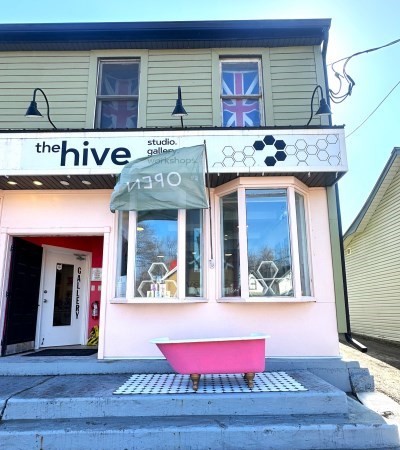Doors Open

Explore some of the stories, places and people that helped to shape our community during Doors Open Ontario in Loyalist Township this June. Tour unique buildings, hidden gems, and fascinating spaces while connecting to our rich history - all for free!
As part of the province-wide Doors Open Ontario celebration, this event invites you to immerse yourself in Loyalist's rich heritage. Don't miss this exciting opportunity to uncover history and celebrate our vibrant community. Plan your adventure today!
New this year, visit five participating sites and be entered into a draw for a chance to win one of three prizes valued $100 each! The draw will take place on June 20 and the winners will be notified directly.
When
Date: Saturday, June 14, 2025
Time: 10:00 a.m. to 4:00 p.m.

2025 Participating Sites
| Bath Museum & Visitor Centre, 434 Main Street, Bath |
|
Site Information: The Bath Museum and Visitor Centre has served the Village of Bath in many different capacities since it was first built in 1861. It was originally built to serve both as the Town Hall and a Court House. It then became the municipal office for the Village of Bath, a title the building held until 1970. Afterwards, it was used as an auction house, a concert hall, a Legion Hall, and a sports venue, among other community uses. Today, the building serves as the Bath Museum and Visitor Centre with exhibits that will take you on a journey through cherished Bath history from pre-colonial times all the way to World War II, beginning with an archaeological history of the First Nations in this region. Visitors will find no shortage of historical exhibits inside the museum including artifacts from United Empire Loyalists, WWI and WWII memorabilia. The museum has a rich collection of arrowheads and tools dating back 400 years. Learn more about Bath's rich history by vising the Bath Museum and Visitor Centre during Doors Open on June 14! |
| Bath United Church, 402 Academy Street, Bath |
|
Site Information: While the first Methodist meetings in what is now Loyalist Township, led by preacher William Losee, were held in 1788, it was not until 1812 that the first permanent home for the Methodist congregation in Bath was constructed. While the congregation's original Masonic Hall home has since been lost, the 1849-built Bath United Church on Academy Street stands strong. The church first opened its doors on September 30th, 1849 and has been in continuous use since that time. The church as it exists today, and as it stood before 1950, is a variant of the type of classical parish church developed in England by Sir Christopher Wren, a highly acclaimed English architect, best known for his masterpiece, St. Paul’s Cathedral in London. Learn more about the history of the building and its congregations and marvel at the church's beauty during Doors Open on June 14! |
| The Hive, 363 Main Street, Bath |
|
More than just a gallery, The Hive is a space where art comes to life. Through exhibitions, artist talks, workshops, and special events, the Collective aims to inspire and engage both artists and the community alike. Whether you're an emerging artist or an art lover, The Hive is a welcoming space for all. As a first time Doors Open site, visitors will have the opportunity to explore our studio, meet resident artists, and learn about the diverse range of art forms and workshops we offer. From visual arts to crafts, The Hive is dedicated to fostering creativity and collaboration within the community. Join us in celebrating this milestone and experience the artistic energy that defines The Hive. We look forward to welcoming you on June 14! |
| Layer Cake Hall, 193 Davy Street, Bath |
|
Featured Activity: Layer Cake Hall is currently the home of the Lennox and Addington County Library, Bath Branch. Join Library staff on June 14 for a fun free activity! Site Information: Originally built in 1859, the Layer Cake Hall is an excellent example of Carpenter's Gothic Revival architecture and the only one of its kind in Bath. Examples of this architecture style are not widespread in Ontario. This structural design movement began in England and has distinctive features including finials, scalloping and lancet mouldings. The Bath Chapter of the Mechanic's Institute commissioned the building; however, ownership of the building was transferred to local carpenter Abraham Harris in 1859 when the Institute could not afford to pay for the construction. Ownership of the Hall passed through many hands and the Hall has served many different functions and groups, such as the Ladies Auxiliary, before providing a space for the Millhaven Women's Institute (WI). In 2019, ownership of the Hall was transferred to Loyalist Township who have continued to place dedicated effort towards the restoration and preservation of this unique building. The Township was awarded funding in 2021 to assist with the costs for the restoration of the Layer Cake Hall. The detailed restoration project was awarded to Ecclesiastical Refinishing, and the restoration work took place in 2022. In 2023, Loyalist Township was honoured to be the recipient of the Frontenac Heritage Foundation's Heritage Conservation Award. |
| St. John's Anglican Church, 212 Church Street, Bath |
|
Site Information: The very first Anglican Church proper in Upper Canada was a log building built in 1787 within the Village of Bath. The precise location of this first structure is unknown, but it is thought the land it was built on had been donated by John Davy Sr. who was a United Empire Loyalist and a resident of great importance to the development of Bath. Before the church was built, the first religious service in the county was held in 1785 at the home of Captain Jeptha Hawley, which still stands in Bath today. The service was conducted by Reverend John Stuart. The property that the St. John’s Anglican Church is currently located on was once part of the 200 acres which was granted to Lieutenant George McGuiness, who served with the Indian Department in the American Revolution. William Fairfield purchased the land and later donated a portion to the Church. |
| Babcock Mill, 100 Bridge Street, Odessa |
|
Site Information: The Babcock Mill was built in 1856 by the Saul Brothers, a firm of stonemasons, for Philip D. and John K. Booth. Originally, the Mill was intended to be used as a gristmill, but it was never outfitted for this purpose as the Grand Trunk Railway brought in cheaper flour from Toronto and Montreal to the area, outpricing the Mill. Instead, the Mill was used as part of the Booth family's Woolen Mill. Later in 1907, the Mill was sold to John Herbert "Herb" Babcock. John Babcock then outfitted the Mill to make wooden baskets, installing line shafts, pulleys and belts. The baskets that John Babcock designed were known as the "Better Basket by Babcock". Babcock Baskets were made of thin hardwood staves, usually maple, woven together with galvanized wire, with the rim and bottom hoops being made of elm. In 1926 the Mill was redesigned and used to power both the Mill and the generator, which supplied electricity to the Babcock business and the Odessa community. Basket making ended in the 1950s and the Mill was later used to manufacture truck bodies. The Mill was then sold to (now) Loyalist Township in 1977, where from 1986 to 1993 Donald Babcock and several students operated the Mill, making baskets and giving tours until its closure in 2005. In 2023, Loyalist Township proudly reopened the Mill for summer tours. Explore the history of the Babcock Mill and its basket making process during Doors Open on June 14. |
| Second Chance Ranch, 6038 Hwy 2, Odessa |
|
Featured Activity: Second Chance Ranch invites you to visit the farm, meet the friendly animals, and learn how you can support animal rescue. Site Information: Second Chance Ranch is a special farm providing more than just the basic life requirements of food, water and shelter for animals needing care. They are committed to the rehabilitation of animals of all breeds by addressing behaviour and training challenges. This improves the quality of their lives and improves the chances of success in the ultimate goal of being their forever home or re-homing. The farm is inviting you to come and experience the positive and friendly environment and visit the animals on June 14! |
| Wilton Cenotaph, Simmons Road and Fisk Road intersection |
|
A cenotaph is an empty tomb or monument built in honour of a person or group of people buried elsewhere - sometimes in unknown graves. They especially commemorate people who were killed in conflicts. Often known as War Memorials, they help us to never forget the sacrifice of those who died and serve as a gathering place for ceremonies on Remembrance Day. The Wilton Cenotaph, unveiled on August 17, 1920, was erected to remember the five members of the Wilton community who served and died in the First World War (1914-1918). Those five brave service members were Walter Bush Lieut., William. R. Davy, Herbert Blanchflower, James Hutchison, and Harry Smooth. One amongst them, Walter Clarence Bush survived the battle at Vimy Ridge as part of the 3rd Battalion of the Canadian Expeditionary Force, a battle that saw 10,600 Canadians killed or wounded. A couple of weeks later, Lieutenant Bush was killed after his shelter was struck by enemy artillery. He is buried in the Aubigny British Cemetery in Nord-Pas-de-Calais, France. Learn more about the area's First World War history by visiting the Wilton Cenotaph during Doors Open on June 14. |
| Wilton Hall, 251 Simmons Road, Wilton |
| Information coming soon. |
| Wilton Cheese Factory, 287 Simmons Road, Wilton |
|
Since 1867, the Wilton Cheese Factory has been producing delicious cheese in the hamlet of Wilton! In 1921, the business was taken over by a Farmers Cooperative venture, which is a business owned and controlled by farmers, ranchers, and growers. Under their guidance, the plant manufactured 500,000 pounds of cheese every year but by the 1970s both production and quality had declined. In 1978, the factory was purchased by Arne M. Jensen of Simcoe. One of the stipulations of the purchase was that the factory should maintain its original name and continue its cheese-producing operation. This stipulation was needed for a community whose second closest cheese factory was in the Harrowsmith area in Frontenac County. The Jensen family respected that request, and the Wilton Cheese Factory has continued its original purpose. Arne Jensen was a Master Cheesemaker from Denmark who established Jensen Cheese in 1925. The company continues to use the old-world curing process to produce their cheese products at the Wilton Cheese Factory. After all this time, the basic recipe used at the factory to make the cheese has not changed much. Learn more about the factory's history and try some of their famous cheese during Doors Open on June 14. |
| Wilton Standard/Wesleyan Church, 242 Simmons Road, Wilton |
|
The Wilton Church was built in the late 1800s as part of the Holiness Movement Church, founded by R.C. Horner from Shawville, Quebec. In 1918, the congregation voted to join the Standard Church of America. The name "Standard" comes from the old word for a flag taken into battle by an army to indicate who they represented. Soon a second church was opened in Violet, and this became a "two-point charge." By 1963, the church underwent significant renovations, drastically altering the church's interior and exterior. In 1975 the church underwent additional renovations that increased the size of the church. In the mid-1980s, with the decline of the Standard Denomination, the decision was made to merge with the Wesleyan Methodist Church of Canada in 2004. Along with their services, the church continues to be active within the community and offers many programs for all ages. Learn more about the Wilton Church's unique history during Doors Open on June 14. |
| Dry Stone Walls, Amherst Island |
|
Featured Activity: Learn about Amherst Island's dry stone walls through an interactive exhibit at Topsy Farms during Doors Open on June 14! Site Information: When Irish settlers migrated to Amherst Island from Ireland, they brought with them a unique way of building walls. Using technical knowledge and skills, these Irish immigrants, most notably John Crowe, built walls using a technique called dry-stacking, where walls are layered without the use of mortar, instead using gravity as the glue that holds the stone wall together. The tradition of building and maintaining these stone walls has continued to this day. In 2015 Amherst Island's dry stone walls were celebrated during Dry Stone Canada’s Irish-Canadian International Dry Stone Festival. During the festival, two major construction projects were completed on the site across from the Amherst Island Public School in just three days by 60 professional wallers and workshop participants. The Minister of Tourism, Culture and Sport, the Irish Ambassador to Canada, the Mayor and Deputy Mayor of Loyalist Township, the Canadian author Jane Urquhart, and the actor Rick Mercer came to watch and participate. |
| Gallery Rossland Gardens, 6400 Concession Road 2, Amherst Island |
|
Open Friday to Sunday from 11 AM to 4 PM, the gallery also welcomes visitors during special events like Waterside Concert Days and the Lennox & Addington County Studio Tour. For those seeking a more personalized experience, private viewing appointments are available upon request. This year marks a special milestone as the Gallery at Rossland Gardens proudly participates in Doors Open for the first time on June 14. As part of this province-wide event celebrating Ontario's rich heritage and cultural sites, we invite you to explore our gallery, meet the artists, and immerse yourself in the vibrant art scene that thrives on Amherst Island. |
| Neilson Store Museum and Cultural Centre, 5220 Front Road, Amherst Island |
|
Site Information: For almost a century, from 1883 until its closing in 1976, the Neilson Store served Amherst Islanders with all the basic necessities. Founded by James S. Neilson who came to the island from Sandhurst in 1865, the store not only sold commercial goods such as corset laces and oil lamp wicks, but also acted as a social gathering space for islanders. Along with the store, James Neilson had a dock built along the shore which quickly propelled the store to become the commercial centre of the island and provided services in shipping and receiving goods. The store closed in the 1970s and experienced multiple changes in ownership until the building, dock, and ground were sold to Loyalist Township. It is now the Neilson Store Museum and Cultural Centre. Learn more about the history and stories of the Neilson Store through interactive exhibits during Doors Open on June 14! |
| St. Paul's Presbyterian Church, 1955 Stella 40 Foot Road, Amherst Island |
|
Site Information: Although Presbyterians from the Ards Peninsula and County Down in Northern Ireland had arrived in Amherst Island during the 1830s and 1840s, it was not until 1849 that they were organized under the Rev. McLeishe, who conducted the first service under the trees near where worship takes place today at St. Paul's. A frame church was erected in 1851 west of the present church with the congregation being formally established in 1852 by the Reverend D. McCurdy who hailed from Nova Scotia. The original frame church currently stands on the Allen farm by the ferry dock. |
| Pentland Cemetery, 1652 Front Road, Amherst Island |
| Information coming soon. |
| Topsy Farms, 14775 Front Road, Stella, Amherst Island |
|
Featured Activity: Topsy Farms invite you to explore their lush gardens, take a stroll on their Forest Walking Trail, meet the animals and learn about their unique history. Site Information: Topsy Farms is situated on the northwest end of Amherst Island and includes 200 acres of bushland and is part of a large forest network that covers a large portion of the west end of the island. In 1972 the farm was purchased by "a boatload of free-thinking, peace loving hippies," as self-described by the owners of the farm, who were seeking a different lifestyle. They formed a commune called Headlands Community. The farm grew over time as the community purchased machinery, hay, put in new fencing and began adding animals such as cattle, pigs, chickens, and sheep. Their first fifty ewes were purchased in the summer of 1974 from Manitoulin Island, an island in Lake Huron. Their flock gradually increased to 1,100 breeding ewes by the end of 2017. Today Topsy Farms is a popular tourist destination that offers hiking trails, self-guided farmyard activities, seasonal events, workshops, and classes. In May and June, the farm offers a Adopt a Foster Lamb program. The cost of fostering helps to cover the cost of bottle feeding the lamb, and allows the foster to name the lamb, receive a photo and have one free, staff supervised visit, with the lambs. Visit Topsy Farms on June 14 to meet their animals and also to experience the Drystone Walls of Amherst Island! |
| Fairfield House, 4574 Bath Road, Amherstview |
|
Site Information: The Fairfield House was built in 1793 and preserves the building skills of the Loyalist settlers of eastern Ontario who arrived in 1784. The House offers one of the best-preserved examples of late 18th century buildings in Ontario and allows visitors to view the house's fascinating architecture and interior. Learn about 18th century architecture in Canada, about the Fairfield family and early Loyalist settlers, and admire the view of Lake Ontario during Doors Open on June 14! |
| St. Peter's Anglican Church, 4333 Bath Road, Kingston |
|
Site Information: After holding services in the Collin Bay Public School throughout the early 1950s, Reverend James Peter Scanlon was able to form a strong Anglican congregation. This congregation, with support from the Church Extension Committee of the Dioceses of Ontario, was able to buy land on which to build a new church. This church officially opened on its present site on May 1st, 1959. After being a partner church to various Anglican parishes, St. Peter's grew to become its own parish on July 1st, 1979. Featuring beautiful stained-glass windows located behind the altars, the windows contain specially selected glass based on colour and texture. Learn more about St. Peters Anglican Church's history and marvel at its stained-glass windows during Doors Open on June 14! |
|
Loyalist Township Fire & Emergency Services, Amherstview Fire Hall, 363 Amherst Drive, Amherstview |
|
Site Information: The Emergency Services Department, formed during Loyalist Township's amalgamation in 1998, currently consists of four fire stations: Odessa, Amherst Island, Bath, and Amherstview! These fire stations protect 340 km2 of land and approximately 17,000 residents. The department also responds to assist neighboring municipalities under mutual aid agreements. "Our mission will be accomplished through fire prevention, education, and emergency preparedness programs. When called upon, we will provide a rapid and professional response to emergencies, show compassion for victims, and minimize damages to the environment." See these amazing firefighters in action at the Amherstview Fire Hall during Doors Open on June 14! |
More upcoming events
Contact Us
Municipal Office
263 Main Street, Box 70
Odessa, ON K0H 2H0
T. 613-386-7351
Email Loyalist Municipal Office
Map this Location












 Located in the historic village of Bath,
Located in the historic village of Bath,  Nestled amidst the serene landscapes of Amherst Island, the
Nestled amidst the serene landscapes of Amherst Island, the